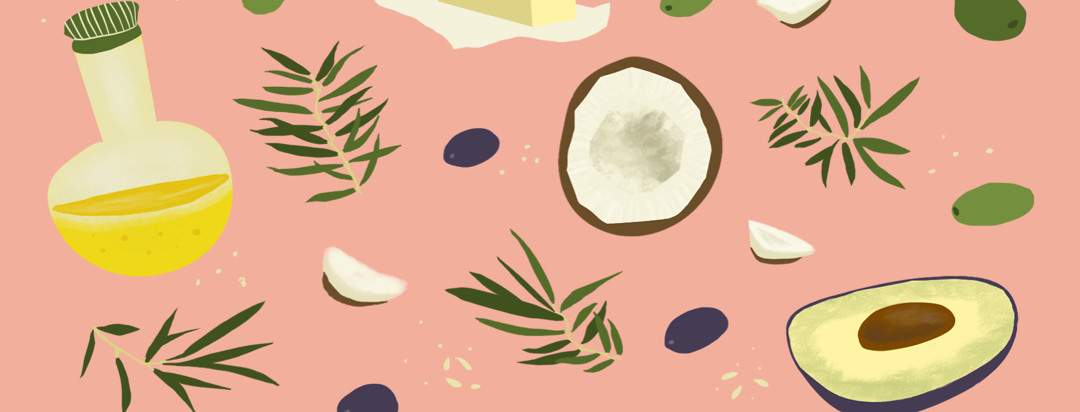What's the Deal with Fat?
In the 2019 edition of the Standards of Medical Care in Diabetes, it is recommended that a lipid panel be completed at the time of diabetes diagnosis.1 A lipid panel test measures lipids- fat and fat-like substances (which are found in the blood and body tissues) and includes:
- Total cholesterol
- HDL cholesterol (“good”)
- LDL cholesterol (“bad”)
- Triglycerides
The results of the lipid panel test help assess risk for atherosclerotic cardiovascular disease which is defined as “coronary heart disease, cerebrovascular disease, or peripheral arterial disease (and) is presumed to be of atherosclerotic origin—(and) is the leading cause of morbidity and mortality for individuals with diabetes.”1 High triglyceride levels and low HDL levels are commonly seen in patients with type 2 diabetes (as well as those with type 1 diabetes).2
Poor glycemic control, poor diet quality, tobacco use, obesity, excessive alcohol intake, and physical inactivity all contribute to dyslipidemia (abnormal amounts of lipids in the blood).2 Treatment typically includes lifestyle modifications (diet and exercise) and medication (which may or may not be started initially).
With so much information (some helpful and some not-so-helpful), I wanted to summarize some key take-away-points that I have learned after reviewing several current publications.
What are the different types of fat?
Triglycerides are the primary dietary fat. Triglycerides are made up of a glycerol backbone and three different fatty acids. These types of fatty acids include: saturated fatty acids, monounsaturated fatty acids, and polyunsaturated fatty acids. Foods that contain fat are typically a mixture of all the fatty acids with some types of fatty acids making up a greater portion than others.2
The types of fat that are considered most important, are the fats our body cannot make on its own, making them essential fatty acids. These essential fatty acids are: omega-3 fatty acid and omega-6 fatty acid and are both polyunsaturated fatty acids.
Now let’s break down some of the health benefits of each of the different kinds of fat:
Saturated fat
The sources of saturated fat include: beef, pork, processed meats, cheese, whole milk, ice cream, coconut, coconut oil, and palm oil.
Evolving research has shown that saturated fat may not contribute to heart disease in the way it was previously claimed and additionally the saturated fat from dairy foods may be protective. Saturated fat from milk increases HDL cholesterol and a changes LDL cholesterol composition from small dense LDL particles to larger enriched LDL particles. “Small dense LDL particles are more strongly associated with CVD than larger enriched LDL particles.”3 Dyslipidemia improves (high triglyceride levels decrease and low HDL cholesterol levels increase)when saturated fat, monounsaturated fat, and/or polyunsaturated fats replace carbohydrates (in particular refined/high sugar carbohydrates).3
Polyunsaturated fat (omega-6 fatty acid and omega-3 fatty acid)
Sources of omega-6 fatty acids include: flaxseed, nuts, seeds, hempseed oil, sunflower oil, corn oil, and soybean oil
Sources of omega-3 fatty acids include: mackerel, salmon, herring, cod liver oil, sardines, flaxseed, walnuts, chia seeds, soybeans, avocado, and dark green leafy vegetables.
Replacing saturated fat with polyunsaturated fat (omega-6) can lower total LDL cholesterol, however, consuming too much omega-6 fat may be detrimental to your health. “Scientists have hypothesized that a diet high in omega-6s but low in omega-3s increases inflammation, while a diet that includes balanced amounts of each reduces inflammation. Western populations are eating large amounts of processed seed and vegetable oils. Some of these oils are loaded with omega-6s.”4 A diet with a low omega-6 to omega-3 ratio can positively impact blood lipids by increasing HDL cholesterol, reducing triglyceride levels, and decreasing the amount small-dense LDL particles.6
Eating fatty fish (a rich source of omega-3 fatty acids) two times per week has been shown to be beneficial in the prevention of heart disease and can positively impact blood lipids.5 Replacing common cooking oils such as corn oil and sunflower oil (with a high percentage of omega-6 fatty acids) with flaxseed oil (which is rich in omega-3 fatty acids) or olive oil can help improve the overall quality of fat being consumed.
Monounsaturated fat
Sources of monounsaturated fat include: olive oil, peanut oil, avocado, peanut butter, nuts (almond, hazelnuts, and pecans), and seeds
Following a Mediterranean eating style, which is rich in monounsaturated fat, has consistently won praise for its potential benefit on glycemic control and cardiovascular disease risk factors.5 By replacing a portion of saturated fat for monounsaturated fat, the risk of type 2 diabetes and cardiovascular disease in healthy adults can be reduced.5 Meals that are high in monounsaturated fat may result in a great reduction in fasting triglyceride levels in comparison to a meal that is high in saturated fat as well as a greater shift from small-dense LDL to larger enriched LDL particles.6
Trans fat
Sources of trans fat include: crackers, baked goods, French fries, stick margarine (many of these foods are now being made without trans fat. Read the nutrition label for information on trans fat content).
Intake of trans fats is associated with an increased risk for cardiovascular disease and should be avoided as much as possible.5
7 take-away tips:
- Eat fresh, whole foods
- Limit intake of processed foods
- Enjoy dairy foods
- Each fatty fish twice per week
- Try alternative oils for cooking such as flaxseed oil, walnut oil, or avocado oil
- Try eating Mediterranean style meals throughout the week
- Replace high sugar, processed carbohydrates with foods that are rich in monounsaturated fat and polyunsaturated fats

Join the conversation